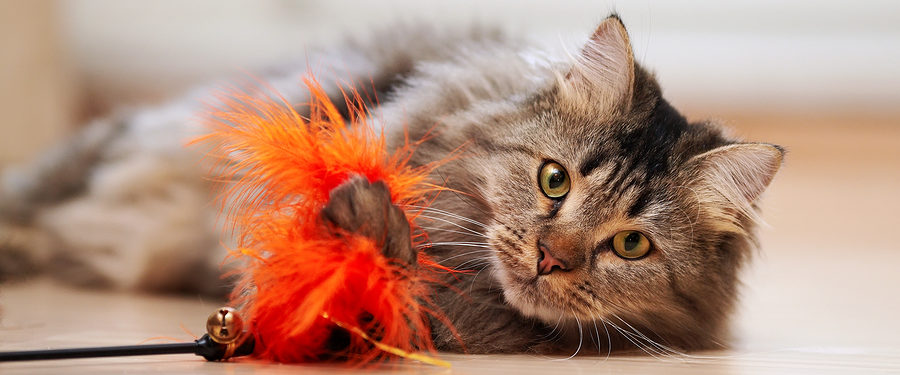Kittens are born with an amazing ability to seek and pounce—but not right out of the womb. That aptitude develops in partnership with physiological changes as they grow.
At first, they are helpless, fully dependent on their mother. Their only focus is staying warm, finding their mother’s teats, and sleeping. Their mother’s licking not only keeps them clean, but also stimulates them to urinate and defecate.
They don’t begin walking until around 17 days, but it takes about a week longer for most to really get their balance. At around the same time, teeth begin to erupt. Soon thereafter, at around four weeks, kittens begin to interact with one another, leading to play. That’s where the fun begins.
Play is Practice
Play at this age is important for many reasons. Kittens learn bite inhibition. If they bite down too hard on a littermate, a yelp is instantly heard and play ceases. Mom may even intercede. Kittens instantly learn to constrain bites in play and perhaps also learn something about the power of a bite.
They practice being cats. They jump and pounce on one another. Pouncing is biologically built into the feline nervous system. Cats are born with hard wiring in their nervous system to instantly tell their brain, “I’ve got something in my paws.” They use hearing, sight, and smell in conjunction with their marvelous whiskers to navigate their environment and learn to seek prey. However, this system doesn’t come with written directions. It’s through play practice that kittens gain understanding of their marvelous powers.
Kittens also develop their renowned agility and sense of balance through play. Though clumsy at first, they’re presumably having fun and simultaneously developing coordination.
Kittens Gone Wild
Kittens live in three gears: Eating, running amok, or sleeping.
An investment to make in kitty is to redirect running amok into appropriate play.
Sometimes another household pet can help you out. One reason (aside from companionship) for adopting a pair of littermates is so they can knock themselves out with play. An adult cat or cats in the home may participate, and even the dog may indulge kitten play, but even for them, dealing with kittens is exhausting. It’s important for human family members to also get in on the play act. It’s not just fun; playing with kittens supports and strengthens the human-animal bond.
Take every opportunity to instruct kitty in the right kind of play. Using hands and fingers, even if under a blanket, is never a good idea. It might be cute to watch a 5-month-old “tiger” pounce on the blanket covering your tantalizing fingers, but it’s sure not cute when a 5-year-old cat continues to think hands are to bite on.
Kittens like movement (especially when it’s unpredictable) and sound and may also be excited by texture. A plastic top from a milk carton or a pingpong ball can be as much fun to a kitten as a toy that costs $30.
However, be careful. Kitties may ingest toys when given an opportunity, and they especially like long, dangly items. Avoid using ribbon, yarn, or string as kitten playthings. Those linear foreign bodies can be life-threatening if swallowed.
Also, be sure the toy isn’t scary. Years ago, a company came out with a toy that resembled a mouse on steroids. It was huge, twice the size of most 5-month-old kittens, and made high-pitched sounds. While kittens and cats typically enjoy unpredictable movements, this toy could have run over a kitten. Most kittens were terrified. Just because a toy is available doesn’t mean it’s a good choice.
As kittens get older, remember that all cats are as individual as we are. My sport of choice may be baseball, while others may prefer football. Cats are the same. A ping pong ball bouncing unpredictably in an empty bathtub might be the ultimate game for hockey-loving kittens, while others prefer the standard feather at the end of a stick.
Types of Play
You can’t just give kittens toys and expect them to entertain themselves. That’s only one part of play. They need all three of the following:
- Interactive play with a human
- interactive play with another cat—or sometimes a dog will do.
- Self-Play
Here are the rules of kitten and cat play.
Cats are smart. They’re not as interested in playing with a mouse toy they’ve “killed” 20 times. Rotate toys, retiring old ones for a while and then bringing them back out.
No matter what the play activity, cats prefer multiple short sessions. Many cats will tell us when their mood is right for play.
As cats age, they may be less inclined to interact, so don’t wait for an invitation. Take out the interactive toy with feathers to entice your aging cat.
Play can be painful if cats are overweight or obese, both of which are associated with osteoarthritis. Movement is likely to be a good thing for these cats, but don’t expect an aging, arthritic cat to play like a kitten.
Movement is also important to maintain physical and mental agility and to keep aging cats limber. Some elderly cats appear to have found the fountain of youth and play nearly as much as they did as kittens. Their secret is in genetics, regular preventive veterinary care, good luck, and a lifetime of play.
Other cats – not surprisingly – slow down significantly, which is normal. Even a few moments of gentle play daily make a difference. Expectations are, of course, adjusted depending on any physical limitations.
Play is important for life, not just during kittenhood, offering mental stimulation and physical exercise. Human research shows that adults who play games into old age are more agile and alert and happier because of social interaction. If true for people, why not cats?
This article was reviewed/edited by board-certified veterinary behaviorist Dr. Kenneth Martin and/or veterinary technician specialist in behavior Debbie Martin, LVT.








